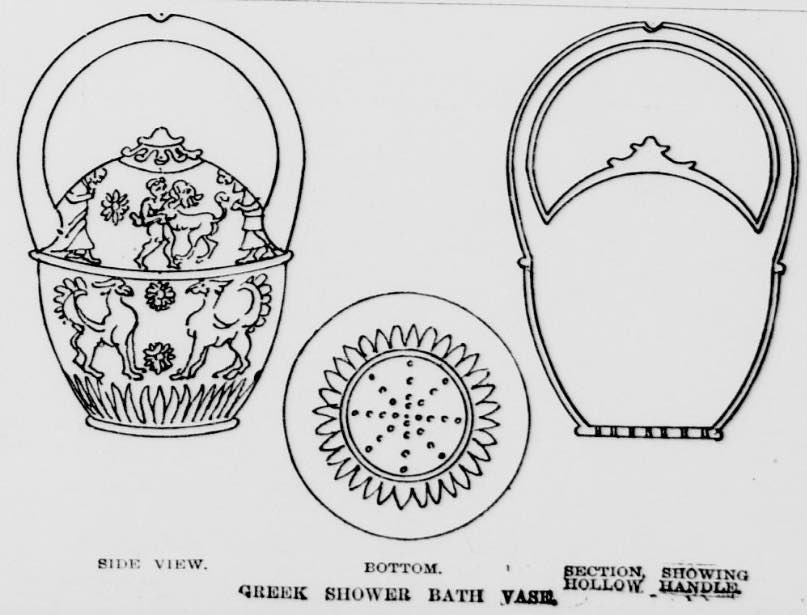
A Greek shower vase? Given how intelligent and innovative the ancient Greeks were, it is little wonder that they created a shower vase.
The article below is about the vase and was published in 1900.

A Greek Shower Bath Vase
It is More Than Two Thousand Four Hundred Years Old
A curious and unique object, one which is not the least of the treasures of the great Museum of the Louvre at Paris, has lately been added to the ceramic collections of that vast storehouse of art. It is a vase whose shape, color and style of ornamentation – called “black figured” – enable an expert to fix upon Greece as the place, and the sixth century before Christ as the date of its manufacture. The shape of its body is ovoid, and it has a curved handle, like that of a basket, but very thick in proportion, for reasons which will be presently apparent.
It is decorated by two zones of figures between conventional ornament at top and bottom. The upper belt pictures Hercules slaying the Nemaean lion, between two draped standing figures; the lower zone represents two griffins between two rampant lions. Rosettes are placed here and there on plain surfaces.
The vase and its handle are hollow throughout, as shown in the sectional drawing, and their only openings are made, respectively, at the bottom of the former, which is pierced by small holes like those of the nose of a watering pot, and at the upper outside edge of the handle, where an opening has been made, but one so small as to be easily closed by the ball of the thumb. The height of this vase is about nine inches, and its cubic capacity about two quarts of liquid.
M. Pottier, the archaeologist and authority on Greek pottery, in describing and commenting on this peculiar vessel, thinks that it must have been filled at the upper opening by means of a small funnel, but cannot decide whether it was used for toilet purposes or as a watering pot.
If the utensil was filled through the opening in its handle it would have been necessary, simultaneously, to close the holes in the bottom, for otherwise any liquid would have run out as fast as poured in. It could be more quickly, and was most probably, done by plunging the vase into a larger one containing the liquid to be used; the air inside would then have escaped through the hole in the handle, the liquid would have taken its place, and the manipulator, having closed the opening in the handle, could then have carried the vessel and its contents wherever he chose and emptied it on whomsoever he pleased by merely removing his thumb from the hole in the handle; for, so long as that aperture was closed, the normal pressure of the atmosphere kept the water in the vase, which is obviously a sprinkler, or hand shower bath.
The small size and capacity of this curious object, the archaic beauty of its ornamentation, and its probably cost, take it out of the category of watering pots or garden tools, and relegate it among the appurtenances of a luxurious toilet equipment. This theory is confirmed by the striking analogy in probably and actual use between the modern French toilet or bath utensil called an eponge Americaine, or American sponge, and its Greek prototype just described.
Notwithstanding its name, few Americans have ever seen or heard of the American sponge. This tin frustum of a cylinder and its handle are hollow throughout, and their only openings are at the lower end, which is pierced with many small holes, and on the upper outside edge of the handle, where a hole which can readily be closed by the ball of the thumb, or as easily unclosed, is made. This vessel is filled by immersion in water, and the discharge and direction of its contents are regulated by the hand and thumb of the manipulator, as in the use of the Greek vase.
The latter was found in what once was ancient Boeotia; it may have adorned the toilet table of Corinna, or cooled the brain of Pindar, for it was a contemporary of that poet and his rival of the fairer sex. It is the first actual existing proof that the Greek industrial classes of the sixth century before Christ were familiar with the laws of hydrostatics and atmospheric pressure.
This archaic Greek shower bath adorns one of the rooms of the Galerie Ceramique of the Louvre, and is marked C.A. 822.
Source: New-York tribune. (New York [N.Y.]), 29 April 1900.

